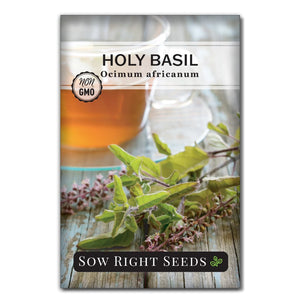How to Grow St John's Wort Plant from Seed for Improved Mental Health
Medicinal herbsSt. John's wort is an easy-to-grow shrub known for its beautiful yellow flowers and healing properties. In the world of medicinal herb gardening, the cultivation of healing plants becomes a therapeutic journey in itself. We’ll guide you through how to grow St. John’s wort from seed in your own garden so you can enjoy its many benefits.

St. John’s wort (Hypericum perforatum) is an herbaceous perennial with bright yellow flowers. This herb is named after the biblical St. John the Baptist due to its flowers coming into full bloom on or around his birthday on June 24. St. John’s wort has been used in Traditional European Medicine since Ancient Greece and continues to be one of the most purchased herbal products in the United States.
How to Plant St. John’s Wort Seeds
To start St. John’s wort from seed, sow seeds outdoors in the fall or start indoors 6 to 8 weeks before the last spring frost.
St. John’s Wort Seed Germination Tips
St. John’s wort seeds that are sown outdoors in the fall will overwinter and sprout in the spring.
When seeds are started indoors, they will need cold stratification for 4-6 weeks to improve germination.
St. John’s wort seeds require light for germination, so gently press seeds into the top of the growing medium.
Seeds will germinate in 14 to 21 days when soil temperature is above 70ºF.

Transplanting St. John’s Wort Plants
Once the St. John’s wort seedlings are several inches tall with two sets of true leaves and all danger of frost is passed, they can be transplanted outdoors. Harden off the seedlings and transplant them into a spot with well-draining soil in full sun to partial shade, spacing plants 18”-24” apart.

Growing St. John’s Wort Plants
Soil
St John's wort is not fussy and will grow in all kinds of soil. For good growth and plenty of blooms, plant in nutrient-rich soil. Ensure it is well-draining to avoid root rot.
Sun
This adaptable herb can grow in full sun or part shade. However, as with most plants, growing St. John's wort in full sun will result in more flowers.
Spacing
Give St. John’s wort plants some space to spread. Place plants 18 to 24 inches apart. The Hypericum perforatum variety can spread two to three feet and grow 6 feet tall.
Fertilizer
The application of additional fertilizer is unnecessary for growing St. John’s wort. If you have very poor soil, adding a layer of well-rotted compost in early spring can be beneficial. Too much nitrogen will have a detrimental effect on blossoms and medicinal strength.

Harvesting St. John’s Wort
The best time to harvest the flowers of St. John’s wort is right when they come into bloom at the end of June. A clear indicator that they’re ready to be harvested is when you see a red pigment on your skin after crushing a flower between your fingers. The flowers and leaves are best used fresh.

Medicinal Uses for St. John’s Wort
St. John’s wort is a popular choice for treating depression, anxiety, ADHD, insomnia, and restlessness. Commonly paired with lemon balm, St. John’s wort has proven to be very effective for SAD (Seasonal Affective Disorder) and OCD.
Because St. John’s wort helps balance the hormones, it can reduce and relieve depression, fatigue, cramping, bloating, and mood symptoms of PMS and menopause.
By calming the digestive organs and attacking harmful bacteria and viruses, St. John’s Wort is effective against ulcers, gastric problems, and infective digestive problems, such as gastroenteritis, dysentery, and diarrhea.
When used as a tincture:
St. John’s Wort can alleviate the physical symptoms of mild opiate withdrawal and relieve anxiety and depression for those quitting smoking by calming the nervous system.
The diuretic properties of St. John’s wort can flush out toxins through urination. The diuretic properties can also help bedwetting children by flushing the excess fluids out of the system before bedtime, preventing the buildup of fluids in the bladder!
When used as a topical oil or salve:
The tannins in St. John’s wort promote the healing of burns, bruises, sunburns, injuries, wounds, and infections due to its excellent antiseptic, antiviral, and antimicrobial properties.
When massaged into muscles, it can help relieve back pain, muscle pain, or general body aches. The oil of St. John’s wort is a fantastic choice for hemorrhoids, as it reduces inflammation, relieves pain, and expedites healing.
People with nerve pain, sharp or convulsive trigeminal neuralgia, sciatica, and Bell’s Palsy have benefited greatly from using St. John’s wort internally as a tincture or tea and as a topical oil/salve on affected areas. When used daily, it can relieve inflammation and pain symptoms of joint diseases, such as arthritis and gout, with increased benefits over time.
Lastly, St. John’s wort is an expectorant, making it effective against chest colds, congestion, respiratory disease, and influenza. It helps clear chest congestion and phlegm, healing infections and common coughs and colds.
St. John’s Wort Tincture Recipe
Ingredients:
St. John’s wort flowers and leaves
80-proof grain alcohol or vodka
Directions:
Loosely pack the flowers and leaves into a clean jar with a tight-fitting lid, filling it to the top. Add the alcohol, fully covering the flowers and leaves. Tighten the lid and label. Gently shake the jar daily for 4 to 6 weeks, adding more alcohol as needed. Strain out herbs and store in a cool, dark cupboard.
St. John’s Wort Infused Oil Recipe
Ingredients:
4 oz (112g) fresh St. John’s wort flowers
2 cups organic olive oil
Directions:
Combine flowers and olive oil in a double boiler and place over very low heat. Steep for 2 to 3 hours, keeping at a low simmer. Strain herbs from oil and store oil in a cool, dark cupboard.
** To make it into a salve, heat 1 part beeswax to 3-5 parts infused oil in a double boiler. More beeswax will make for a firmer salve. Store in a dark, cool cupboard or in the refrigerator to extend its shelf life.
Warnings
St. John’s Wort should not be taken by those diagnosed with bipolar disorder, as it can increase the risk of mania. St. John’s Wort interacts with a lot of modern medicines, such as Warfarin, Digitoxin, HIV medications, and SSRIs. It can cause sun sensitivity to very fair-skinned people. Do not take for 2 weeks before surgery. Check with a physician prior to using.
Does St John’s wort come back every year?
St John's wort is a hardy perennial and will come back each spring.
Does St John’s wort spread?
St. John’s wort spreads through rhizomes. This makes it a good plant for preventing erosion but can be a problem in areas where it might overtake other desired plants.
Add St John's wort plant to your healing garden and enjoy its beautiful flowers and many medicinal uses.
Written by Ashley Clark
Found this information helpful? Share it with a gardening friend!











Leave a comment